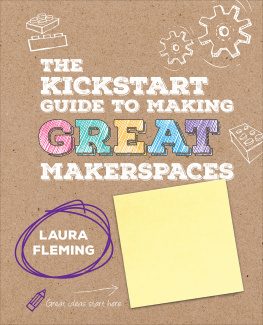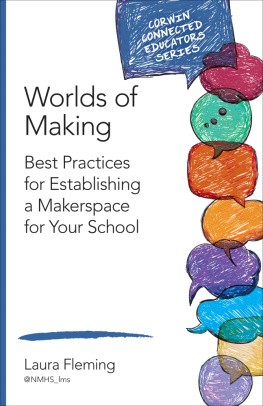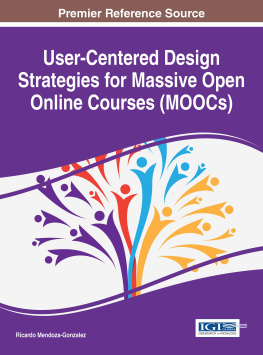First published 2016
by Routledge
711 Third Avenue, New York, NY 10017
and by Routledge
2 Park Square, Milton Park, Abingdon, Oxon OX14 4RN
Routledge is an imprint of the Taylor & Francis Group, an informa business
2016 Taylor & Francis
The right of Kylie Peppler, Erica Rosenfeld Halverson, and Yasmin B. Kafai to be identified as the authors of the editorial material of this work, and of the authors for their individual chapters, has been asserted by them in accordance with sections 77 and 78 of the Copyright, Designs and Patents Act 1988.
All rights reserved. No part of this book may be reprinted or reproduced or utilised in any form or by any electronic, mechanical, or other means, now known or hereafter invented, including photocopying and recording, or in any information storage or retrieval system, without permission in writing from the publishers.
Trademark notice: Product or corporate names may be trademarks or registered trademarks, and are used only for identification and explanation without intent to infringe.
Library of Congress Cataloging-in-Publication Data
Names: Peppler, Kylie A., editor. | Halverson, Erica, editor. |
Kafai, Yasmin B., editor.
Title: Makeology / edited by Kylie Peppler, Erica Halverson, and
Yasmin Kafai.
Description: New York : Routledge, 2016. | Includes bibliographical
references and index.
Identifiers: LCCN 2015047214 | ISBN 9781138847767 (v. 1 : hardback) |
ISBN 9781138847774 (v. 1 : pbk.) | ISBN 9781315726519 (v. 1 : ebook) |
ISBN 9781138847804 (v. 2 hardback) | ISBN 9781138847811
(v. 2 : pbk.) | ISBN 9781315726496 (v. 2 : ebook)
Subjects: LCSH: Maker movement in education | Makerspaces.
Classification: LCC T65.5.M35 M35 2016 | DDC 607.1dc23
LC record available at http://lccn.loc.gov/2015047214
ISBN: 978-1-138-84776-7 (hbk)
ISBN: 978-1-138-84777-4 (pbk)
ISBN: 978-1-315-72651-9 (ebk)
Typeset in Minion
by Apex CoVantage, LLC

One way to understand the Maker Movement is as a network of learning communities. What makes it powerful is that these communities can now interconnect more easily and individuals can be part of multiple communities. Makers also show a community spirit that mixes the can-do attitude with an eagerness to collaborate on local, national, and global levels. These communities transcend institutions and inspire individuals and groups to find ways to work and play together.
As part of World Maker Faire in New York City in 2015, I organized an education forum for educators, librarians, and others who are engaging children as makers. I realized that a certain milestone had been reached. We could shift the conversation away from the basic idea of getting making into schools and libraries to discussing how a community of educators has emerged to lead the way by creating makerspaces and specific programs that engage children as makers. The education forum was able to reflect that important progress had been made in educational settings, both formal and informal, largely led by champions of making in education. The forum sought to recognize these champions and also make it possible for more educators to hear from them and learn from their experiences. The first wave of adopters will play an important role in developing the practices of making and working as a community to share and refine those practices.
One of the educators at the forum remarked to me that the Maker Movement in education was unlike anything he had ever seen, in particular, that teachers were the driving force behind the change. Also, he remarked on the informal nature of the change because it has not been driven by large, well-funded initiatives from foundations or governments. Instead, the Maker Movement in education has relied on the resourcefulness and initiative of teachers and librarians who see an opportunity to engage youth in new ways. It is happening in bottom-up fashion with open source strategies rather than closed or proprietary approaches. The best feedback Ive heard from a teacher who saw the impact of making on her students was: This is why I got into teaching in the first place.
This kind of change in education indeed represents a major shift. Mainstream attempts to change the educational system have largely been top-down and expert-driven, standardizing what teachers should teach and testing what students recall. It has managed to alienate many of the stakeholders but, most importantly, children are bored by these methods of teaching and the tests themselves. Such reform efforts have been too much about schools and not enough about learning. The Maker Movement in education is taking a different tack, which has a tradition reflected by John Deweys phrase learn by doing and Seymour Paperts insights that he called constructionism. I see it as creating the physical, mental, and social conditions for a child to learn through real-life experiences that are personal and meaningful. (Dewey said that education was not about preparing children for the life ahead of them but instead to engage them in life itself more fully.) Maker-centered learning is built around student interests as developed through projects that support learning new skills and capabilities. Creative hands-on projects allow children to demonstrate not just what they know but what they can do. They are also importantly a form of self-expression by which students can connect with others in the community. Through maker-centered learning, students can discover creativity in themselves and develop an ability to solve problems using science and technology.
Yet, by any measure, the majority of work to bring making into education lies ahead. While some schools are making progress, there are many who have not understood how, what, or why they might engage students as makers. Even getting started with a makerspace can be daunting to some, while it can be an adventure to others. However, a makerspace is just a means to an end; it is nonetheless an important effort to provide open access to tools, materials, and expertise that help children become makers. How does it become a truly productive learning environment? How can more teachers learn the practices of making and appreciate its mindset? How can schools aim to reach everyone through making, not just a select few? This book can increase the opportunities for making in educational settings by sharing the insights of many leading practitioners.
Our goal should be helping children see themselves as good learners, as lifelong learners. We should help them identify their own emerging talents as makers. Doing so will help them lead productive lives and participate meaningfully as a member of many communities, as makers do today. As individuals, they will have a sense that they can learn everywhere, and from everyone, and not just in school. The impact of what they create, design, shape, and build will be known in the future, but the time for making it happen is now.
Dale Dougherty
Founder and Executive Chairman, Maker Media, Inc.
MAKE magazine and Maker Faire
Maria Bakker is an undergraduate research scholar in the Learning in the Making lab at University of WisconsinMadison. In 2013, Maria presented her research on makerspaces at the Undergraduate Research Symposium at UWMadison. The research focused on how makerspaces can act as a learning environment. More recently, she has worked alongside Dr. Erica Halverson by focusing on what and how young people learn through making. Marias interests are in understanding how children develop physically, mentally, and socially to increase the individuals well-being as they age.












